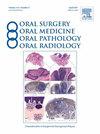利用手机和人工神经网络实时检测咬翼x线片龋病的初步研究
Oral surgery, oral medicine, oral pathology, oral radiology, and endodontics
Pub Date : 2023-09-05
DOI:10.3390/oral3030035
引用次数: 0
摘要
本试点研究旨在实施和评估实验性人工智能(AI)手机应用程序在使用后置手机摄像头实时检测咬翼x线片(BWRs)上的龋齿病变方面的性能。作者使用来自互联网的190张放射图像训练了一个高效神经网络。训练后的模型被部署在谷歌Pixel 6手机上,并用于检测另外10个互联网bwr上的龋齿。相对于静止BWRs的移动视频中固定扫描的BWRs,总手持检测BWRs龋的灵敏度/精度/F1得分分别为0.675/0.692/0.684 ~ 0.575/0.719/0.639。对总结果进行平均,人工智能应用程序使用后置手机摄像头实时检测到10个bwr的62.5%的龋齿病变,精度为70.6%。结合人工智能应用程序的相对易用性和速度以及全球可访问性的潜力,这项概念验证研究可以真正地将人工智能在改善患者护理方面的巨大潜力放在牙医手中。本文章由计算机程序翻译,如有差异,请以英文原文为准。
Real-Time Caries Detection of Bitewing Radiographs Using a Mobile Phone and an Artificial Neural Network: A Pilot Study
This pilot study aimed to implement and assess the performance of an experimental artificial intelligence (AI) mobile phone app in the real-time detection of caries lesions on bitewing radiographs (BWRs) with the use of a back-facing mobile phone video camera. The author trained an EfficientDet-Lite1 artificial neural network using 190 radiographic images from the Internet. The trained model was deployed on a Google Pixel 6 mobile phone and used to detect caries on ten additional Internet BWRs. The sensitivity/precision/F1 scores ranged from 0.675/0.692/0.684 to 0.575/0.719/0.639 for the aggregate handheld detection of caries in static BWRs versus the stationary scanning of caries in a moving video of BWRs, respectively. Averaging the aggregate results, the AI app detected—in real time—62.5% of caries lesions on ten BWRs with a precision of 70.6% using the back-facing mobile phone video camera. When combined with the AI app’s relative ease of use and speed and the potential for global accessibility, this proof-of-concept study could quite literally place AI’s vast potential for improving patient care in dentists’ hands.
求助全文
通过发布文献求助,成功后即可免费获取论文全文。
去求助
来源期刊
自引率
0.00%
发文量
0
审稿时长
1 months

 求助内容:
求助内容: 应助结果提醒方式:
应助结果提醒方式:


